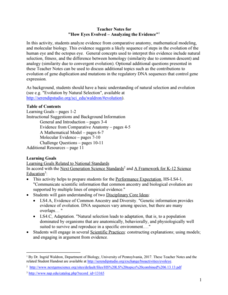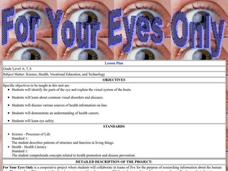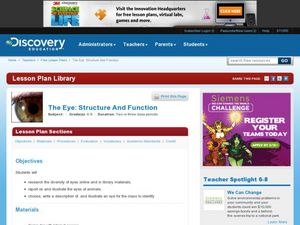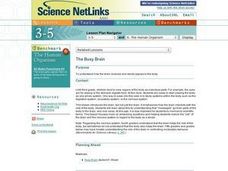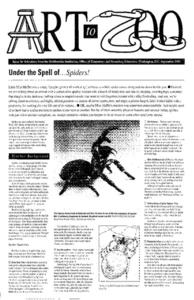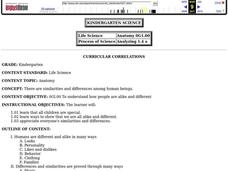Serendip
How Eyes Evolved – Analyzing the Evidence
Octopodes existed for hundreds of thousands of years before humans, yet our eyes share many similarities. Scholars analyze the evidence to determine if the evolution of eyes best fits a homology or analogy model. They discuss the issue...
Curated OER
For Your Eyes Only
Students complete several activities in a unit related to the eye. In this eye activity, students work in groups to research information about the human eye and create a multimedia presentation. They research anatomy of the eye, how the...
Curated OER
What is the Anatomy of the Visual System?
Learners research the structures and functions of the eye. In small groups they dissect a model of the human eye, identify structures of the eye, and describe the functions of the photoreceptors.
Curated OER
X-Ray Eyes
Students observe Australian X-ray paintings for information and to understand the art techniques used. Then they imagine and draw the inner organs of an animal. Students also research the anatomy of the animal to analyze the accuracy of...
Curated OER
The Eye; Structure and Function
Students research the structure and function of the eye. In this anatomy lesson, students write a report about the eye and draw an illustration. They research a particular animal's eye then present their findings to the class without...
Curated OER
Superhumans & Bionics; Electronic Eyes
Students examine the anatomy of the eye and the physiology of vision. Students participate in a modeling activity to demonstrate the difference between a healthy eye and an eye affected by macular degeneration. Students match part of...
Curated OER
Human Body Simon Says
Young scholars display their new knowledge of human body parts' names and locations, by playing an adaptation of the game Simon Says. A more sophisticated version of the game can be played with older students as they learn more specific...
Curated OER
Proportion of the Human Form
Students discover proportions of the Human Body. In this anatomy lesson, students create replicas of the Human body using nothing but paper and glue. Students share their creations with the entire class.
Curated OER
Challenges and Changes: Sensitivity to Vision & Hearing Compromises
Students examine the structure of the eye. In this eye anatomy lesson students complete a lab activity of the human eye.
Curated OER
Growing Eyeballs
Students investigate vision and the anatomy of the human eye. They complete a Webquest, watch a video about the structure of the eye, take an online quiz, answer discussion questions, and read newspaper articles about activities that...
Curated OER
The Busy Brain
Students explore biology by completing a human body worksheet. In this human brain lesson, students identify the different anatomy within the brain and the functions those pieces form. Students read an article about signals in the brain...
Curated OER
Buzzing Bee's Wardrobe
Students investigate the anatomy of honeybees. In this anatomy instructional activity, students research the physical characteristics of bees and discover what they do. Students create a model of a honeybee showing the correct anatomy.
Curated OER
Dissection Scramble
Students discover the anatomy of a human body by dissecting a cow's eye. In this animal dissection lesson, students identify the structure of an eyeball by cutting open a cow eye and observing the insides. Students...
Curated OER
Body Parts in Spanish
Students use Spanish to recognize and recall body parts. For this Spanish anatomy lesson, students identify and name the parts of the body in Spanish. Students describe a person physically by his hair and color of eyes. Students graph...
Curated OER
What Is It? Tommy Tastes
Students complete multi-curricular to learn about senses and sensory words. In this sensory words instructional activity, students discuss the five senses and the anatomy of a tongue. Students complete a food tasting activity and find...
Curated OER
Fish Fashion 101
Young scholars explore fish anatomy. For this fish anatomy and adaptation lesson, students define and identify the location of fish body parts. Young scholars add these parts of a fish's anatomy to a life-sized fish costume worn by a...
Curated OER
Label Your Body
Students assimilate the names of the parts of the body. They practice spelling body part words using a worksheet. They trace the outline of their bodies, add features and label the body parts from the vocabulary list.
Curated OER
Under the Spell of Spiders!
Learners read about spider body parts, abilities, tendencies, and life cycles. In this Under the Spell of Spiders! lesson, students create mystery creatures that turn out to be spiders. Learners catch and observe spiders and insects....
Curated OER
Are You a Frog?
Students listen to the book "Ask Me If I'm a Frog, and compare their anatomy and habits to the anatomy and habits of a frog to identify with the characteristics unique to frogs. They respond to teacher-generated questions by writing...
Curated OER
Anatomy
Students explore the similarities and differences in human beings. They consider that all students are special, and appreciate everyone's similarities and differences.
Curated OER
Levers in the Body: They Are Not What You Might Think!
Students investigate lever systems in the human body and compare arm anatomy to model. In this human levers instructional activity students graph and analyze their results.
Curated OER
ESOL Vocabulary for Body Parts
Students review and write the vocabulary for basic body parts. They identify parts of the body along with new verbs then complete an activity sheet of labeling body parts and complete sentences using the correct vocabulary word.
Curated OER
Review of the Five Senses
Students investigate the five senses. In this human biology lesson, students are given five items and identify which items match best with each of the senses. Students use objects such as a rock, hard candy, and a flower.
Curated OER
What Kind of Insect is That?
Fifth graders characterize insects and classify insects according to the Linnaean system. They use hand lenses or microscopes to examine insect body parts.
